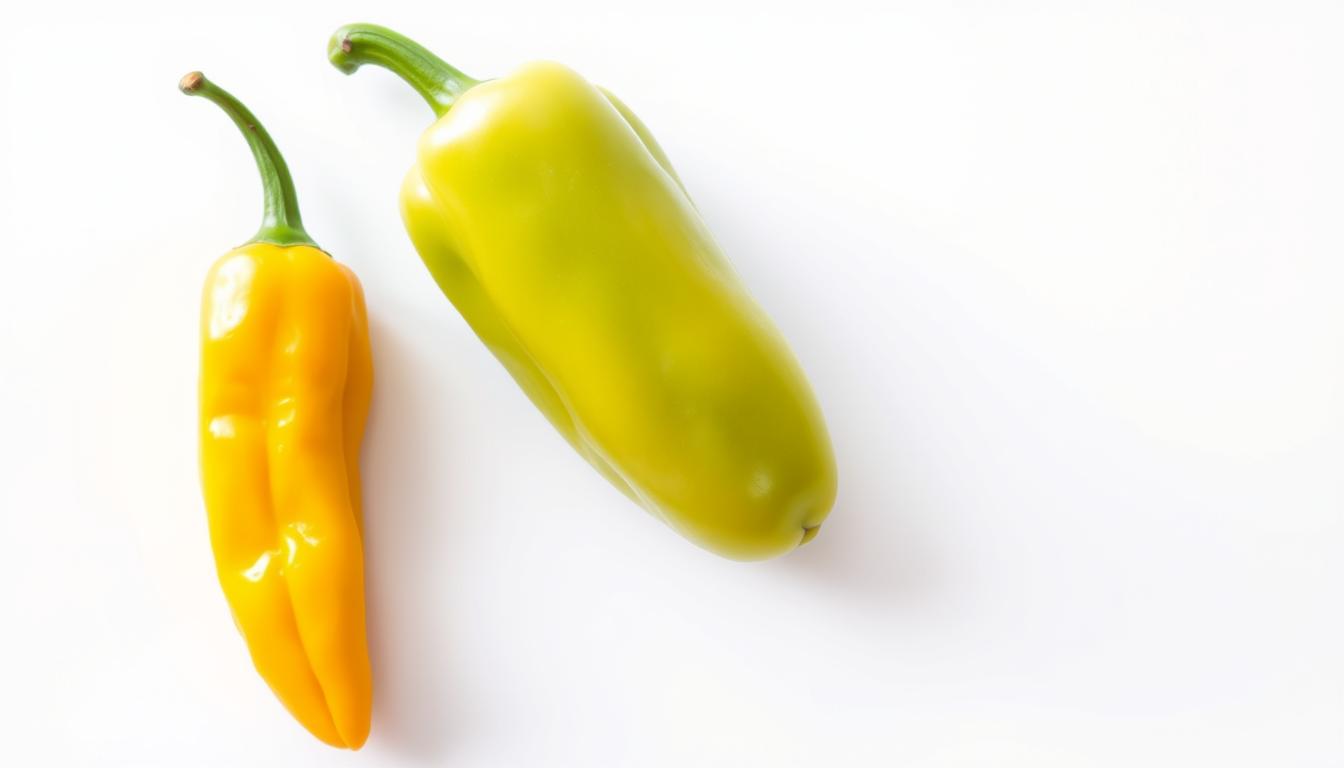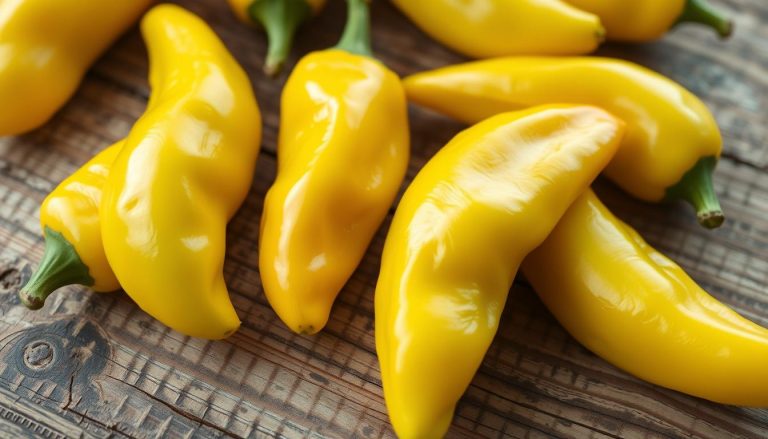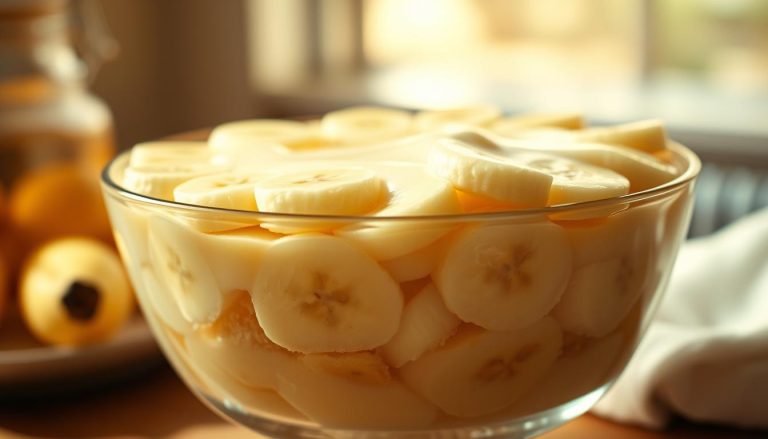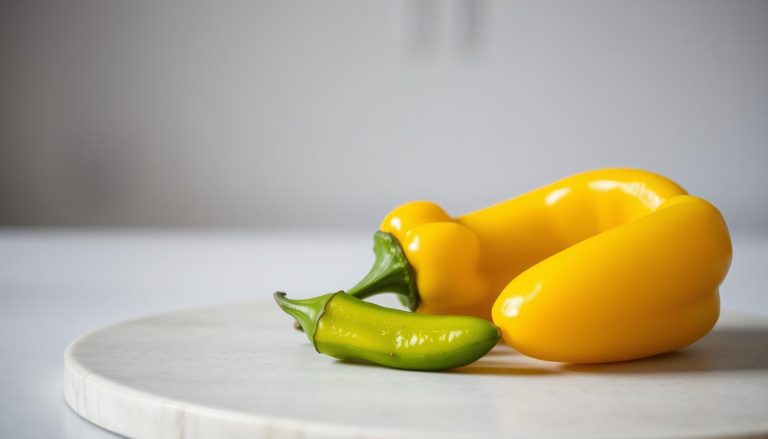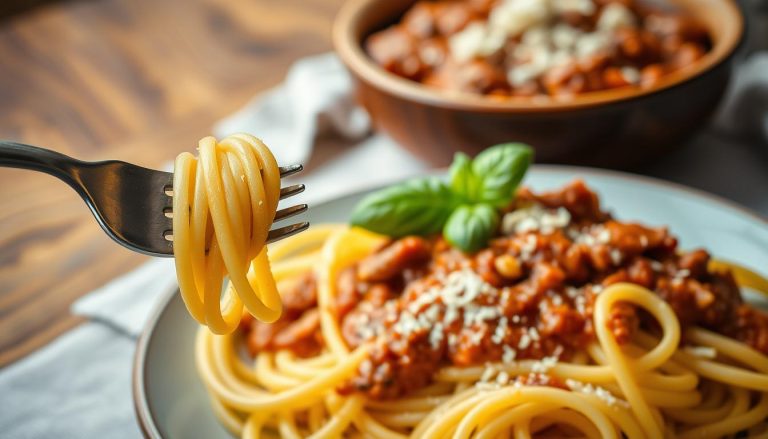Pepperoncini vs Banana Peppers: Key Differences in Taste and Heat
Every kitchen has its own secrets, and peppers are no different. Standing in the grocery store, you might wonder about pepperoncini vs banana peppers. These green peppers may look alike, but they each add something special to your food.
Banana peppers and pepperoncini can turn a simple meal into something amazing. Whether you cook at home or love trying new recipes, knowing the difference between these peppers can make your dishes better. It will also make your taste buds happy.
Today, we’ll dive into what makes pepperoncini and banana peppers unique. We’ll look at where they come from, how hot they are, and how to use them in cooking. This will make you a pepper expert in your kitchen.
Table of Contents
Understanding Pepperoncini and Banana Peppers at a Glance
Peppers add color and flavor to food all over the world. Pepperoncini and banana peppers are two special kinds. They add unique tastes to dishes, loved by both home cooks and chefs.
Physical Characteristics
Pepperoncini are light green to yellow-green, 2-3 inches long, and have a wrinkled shape. Banana peppers look like bananas, being long and curved. They turn yellow to bright red when ripe.
- Pepperoncini: Wrinkled skin, light green to yellow color
- Banana Peppers: Smooth skin, bright yellow to red color
- Length: Both typically 2-4 inches long
Origin and History
Banana peppers come from South America, like Peru and Bolivia. Pepperoncini, however, are from the Mediterranean, especially Greece and Italy. Both have traveled the world, becoming loved in many cuisines.
| Pepper Type | Original Region | Cultural Significance |
|---|---|---|
| Pepperoncini | Mediterranean | Traditional Greek and Italian cooking |
| Banana Peppers | South America | Widely used in global cuisine |
Common Uses in Cuisine
Pepperoncini are great in Greek salads and on pizza. Banana peppers are often in sandwiches, salads, and pickles. Their mild taste makes them great in many dishes.
- Salads and garnishes
- Sandwich toppings
- Pickling and preservation
- Pizza and pasta dishes
The Distinct Flavor Profiles of Both Peppers
Exploring pepperoncini vs banana peppers reveals two unique tastes. Pepperoncini have a tangy, slightly bitter flavor with a mild heat. They add a zesty kick to salads and sandwiches.
Banana peppers, on the other hand, are sweeter and milder. Their sweetness makes them great for both raw and pickled dishes. They have a gentle, fruity taste that’s different from other peppers.
- Pepperoncini flavor characteristics:
- Tangy and slightly bitter
- Mild heat level
- Bright, zesty taste
- Banana pepper flavor profile:
- Sweet and mild
- Subtle fruity notes
- Less intense heat
Pepperoncini and banana peppers have different uses in cooking. Pepperoncini are perfect for Mediterranean dishes. Banana peppers work well in sweet dishes like salads and sandwiches. Your choice depends on the flavor you want in your recipe.
Chefs and home cooks love these peppers for their unique flavors. They add depth and character to many dishes. Knowing the taste differences between pepperoncini and banana peppers can make your cooking better.
Heat Level Comparison: Pepperoncini vs Banana Peppers
Exploring mild peppers is key for food lovers. Knowing the heat levels of banana peppers and pepperoncini is interesting. It shows how these peppers compare.
Peppers are ranked by the Scoville Heat Unit (SHU) scale. This scale shows how spicy they are. Let’s look at the heat of banana peppers and pepperoncini.
Banana Pepper Scoville Rating
Banana peppers are mild and sweet. Their Scoville rating is between 0-500 SHU. This makes them very gentle on your taste buds.
- Mild heat intensity
- Sweet flavor profile
- Versatile in various dishes
Pepperoncini Heat Scale Position
Pepperoncini peppers are a bit spicier, with a Scoville rating of 100-500 SHU. They are still mild but have a unique kick.
Comparing Heat Sensations
Pepperoncini and banana peppers are very similar in heat. The main difference is their taste. Pepperoncini are tangier, while banana peppers are sweeter.
| Pepper Type | Scoville Heat Units | Flavor Profile |
|---|---|---|
| Banana Peppers | 0-500 SHU | Sweet |
| Pepperoncini | 100-500 SHU | Tangy |
Both peppers are great for those who want little heat but lots of flavor.
Nutritional Value and Health Benefits
Exploring what is pepperoncini and banana peppers reveals their nutritional power. They bring health benefits and exciting flavors to your meals.
These peppers are low in calories but high in nutrients. They are rich in vitamins that boost your health:
- Vitamin C for immune system support
- Vitamin A for eye health
- Potassium for heart function
- Antioxidants that combat free radicals
They have only 20-30 calories per serving. This makes them great for those watching their calories.
Their benefits go beyond just nutrition. Pepperoncini and banana peppers can:
- Boost metabolism
- Reduce inflammation
- Support digestive health
- Enhance nutrient absorption
They are a tasty way to add important nutrients to your diet. This doesn’t mean you have to give up on taste or health goals.
Growing and Harvesting Methods
Growing your own banana peppers and pepperoncini is rewarding. Knowing how to grow these peppers can make your harvest better. You’ll enjoy fresh, tasty peppers from your garden.
Pepper cultivation needs attention to specific factors. Banana peppers and pepperoncini have different needs. Each pepper type requires unique care.
Optimal Growing Conditions
When growing banana peppers and pepperoncini, consider these key conditions:
- Soil pH between 6.0 and 6.8
- Full sun exposure (6-8 hours daily)
- Well-draining soil rich in organic matter
- Consistent temperatures between 70-85°F
Harvesting Timeline
The harvesting time for banana peppers and pepperoncini is different:
| Pepper Type | Days to Maturity | Harvest Indicators |
|---|---|---|
| Banana Peppers | 60-75 days | Yellow to bright red color |
| Pepperoncini | 70-80 days | Light green to red color |
Storage Tips
Proper storage keeps your peppers fresh. Store peppers in the refrigerator in a bag with holes. This way, they stay crisp for 1-2 weeks.
- Keep peppers dry to prevent mold
- Avoid washing until ready to use
- Store in the crisper drawer
Popular Culinary Applications and Recipes
Pepperoncini and banana peppers add vibrant flavors to many dishes. Knowing the difference between them opens up new culinary possibilities. These peppers can turn simple meals into exciting dishes.
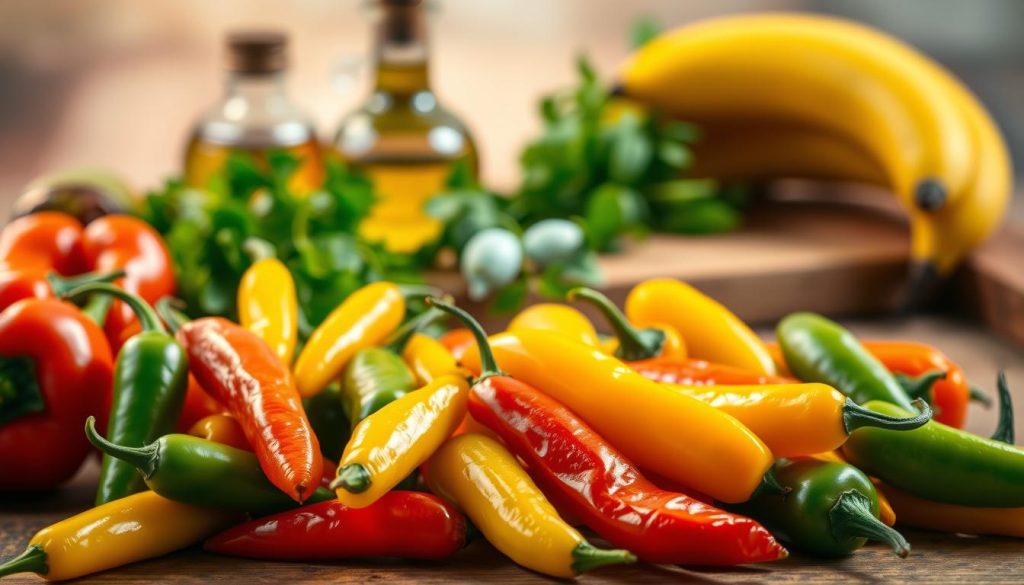
- Greek salads with tangy dressing
- Italian antipasto platters
- Sandwich and pizza toppings
- Charcuterie boards
Banana peppers also have exciting uses:
- Stuffed pepper appetizers
- Pickled condiments
- Grilled vegetable medleys
- Spicy relish preparations
Each pepper has its own unique taste. Pepperoncini add a mild, tangy kick to Mediterranean dishes. Banana peppers are sweeter, perfect for brightening sandwiches and salads.
| Pepper Type | Best Culinary Uses | Flavor Profile |
|---|---|---|
| Pepperoncini | Salads, Antipasto, Sandwiches | Tangy, Mild Heat |
| Banana Peppers | Pickling, Stuffing, Garnishing | Sweet, Mild Flavor |
Trying out these peppers can make your cooking more exciting. They add new flavors and textures to your meals.
Fresh vs Pickled: How Processing Affects Taste
Exploring pepperoncini vs banana peppers shows how pickling changes their taste. This process makes them taste different and can make your food better.
Pickling Techniques
Pickling pepperoncini and banana peppers uses several methods. These methods make them taste better and last longer:
- Vinegar-based brining
- Salt fermentation
- Quick pickling techniques
- Refrigerator preservation
Flavor Transformation During Processing
The pickling process changes peppers a lot. Pepperoncini get tangier and softer. Banana peppers become sharper and more acidic.
| Pepper Type | Fresh Characteristics | Pickled Characteristics |
|---|---|---|
| Pepperoncini | Mild, crisp | Tangy, soft |
| Banana Peppers | Sweet, crunchy | Sharp, acidic |
Choosing between pepperoncini and banana peppers for pickling depends on their flavor changes. Pepperoncini keep more of their natural taste. Banana peppers get more acidic.
Shopping Guide: How to Choose the Right Pepper

Choosing between banana peppers and pepperoncini can be confusing at the grocery store. Knowing how to pick the best peppers can make your cooking better. It ensures you get the right taste for your meals.
Here are some important things to look for when buying fresh peppers:
- Look for smooth, glossy skin without blemishes
- Choose peppers that feel firm and heavy for their size
- Avoid peppers with soft spots or wrinkled skin
For those interested in banana peppers vs pepperoncini, there are visual differences to help you tell them apart:
| Characteristic | Banana Peppers | Pepperoncini |
|---|---|---|
| Color | Bright yellow to green | Pale green to yellow-green |
| Shape | Long and curved like a banana | Shorter and more rounded |
| Typical Length | 4-6 inches | 2-3 inches |
When buying pickled peppers, check the label for important information:
- Verify the specific pepper type
- Check sodium content
- Look for artisan or small-batch brands for better quality
Pro tip: If you’re unsure about which pepper to choose, ask the produce manager or store staff. They can guide you to the perfect pepper for your recipe or taste.
Common Substitutes and Alternatives
When banana peppers or pepperoncini are out of stock, knowing good substitutes can help. Understanding their Scoville rating and taste helps pick the best options.
Finding the right pepper substitute is about heat and taste. Banana peppers are mild and tangy, making them great for many dishes.
Similar Heat Level Options
Looking for peppers with similar heat? Here are some good choices:
- Anaheim peppers (500-2,500 Scoville units)
- Poblano peppers (1,000-1,500 Scoville units)
- Hungarian wax peppers (5,000-10,000 Scoville units)
Flavor Match Alternatives
What’s pepperoncini’s closest flavor match? These peppers share similar tastes:
| Pepper | Heat Level | Flavor Profile |
|---|---|---|
| Cubanelle | 0-1,000 Scoville | Sweet, mild |
| Banana peppers | 0-500 Scoville | Tangy, sweet |
| Pepperoncini | 100-500 Scoville | Bright, pickled |
Try these alternatives to explore new tastes in your cooking.
Conclusion
Exploring peppers, like pepperoncini vs banana peppers, shows interesting culinary differences. These peppers may look similar, but they each add something special to your cooking. Knowing their unique flavors, heat levels, and uses can change how you cook.
Both peppers are great for anyone who loves to cook. Banana peppers are milder and sweeter, perfect for sandwiches and salads. Pepperoncini add a tangy flavor to Mediterranean and Italian dishes, making them stand out.
Remember, your taste is what matters most. You might like the sweet taste of banana peppers or the tangy flavor of pepperoncini. Try different ways of preparing them to find your favorite.
Your journey with pepperoncini and banana peppers is just starting. They offer many uses, health benefits, and unique tastes. Enjoy their differences and similarities, and let your taste buds lead the way in this tasty adventure.

